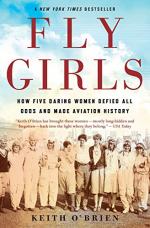|
This section contains 743 words (approx. 2 pages at 400 words per page) |

|
Fly Girls Summary & Study Guide Description
Fly Girls Summary & Study Guide includes comprehensive information and analysis to help you understand the book. This study guide contains the following sections:
This detailed literature summary also contains Topics for Discussion on Fly Girls by Keith O'Brien.
The following version of this book was used to create this study guide: O’Brien, Keith. Fly Girls. Houghton Mifflin Harcourt Publishing Company. New York, NY. First Edition. 2018. The narrative follows an essentially chronological structure as it examines the struggles and successes of pioneering female aviators in the early part of the Twentieth Century.
The book begins with a first-person Introduction by the author, in which he sketches in the history of aviation in the early 1900’s, and how much of the attention focused on aviation came about as a result of frequently dangerous races between male fliers. The author also describes how, in the mid-1920’s, female fliers started to come onto the scene, fighting to be perceived and treated as having the same rights to take risk and reap rewards as men. The author concludes by introducing the five women whose lives and experiences will become the focus of the narrative, and leads the way into that narrative by saying, “It began on the Kansas prairie, with a hard wind blowing” (xiv).
The narrative that follows is divided into three parts. In Part One, the focus is on considering the early lives, ambitions, and activities of the women on whom the narrative will primarily focus. It begins with a description of the early life of Louise McPhetridge Thaden, who became the holder of several aviation records and who was eventually the first woman to win what was widely regarded as the most challenging and most prestigious air race in America at the time. Then there is consideration of the early life of Amelia Earhart, who became arguably the most well-known female aviator not only in America but in the world, more for her mysterious disappearance than for her many achievements. There are also references to celebrity Ruth Elder and to Ruth Nichols, who consistently fought to realize her flying goals in the face of increasingly dangerous obstacles.
In Part Two, the focus of the narrative shifts onto the flying careers of the women upon whom the narrative is focused, and their ongoing struggle for the same rights to competition and to prize money as the men in their field. As part of those struggles, the women found it both necessary and useful to organize themselves, forming a group that eventually became known as the Ninety-Nines. The narration comments that the name came from the number of women who initially signed up as members. As Part Two continues, the narrative follows the efforts of the Ninety-Nines and its individual members, efforts made towards both individual achievement and towards being allowed to enter an important cross-country race sponsored by flamboyant promoter Cliff Henderson. Henderson, after Earhart completed her solo flight across the Atlantic Ocean, proclaimed that the forthcoming year, 1933, as the year “for women’s suffrage in aviation” (158).
Part Three begins with the detailed description of an event that changed Henderson’s mind, and briefly changed the place of women in aviation at the time. That event was the death of rising aviation star Florence Klingensmith, whose determination to succeed in every risk she took as a flier ended in the loss of her life. Part Three then chronicles the different ways that Klingensmith’s death created even greater challenges for Thaden, Earhart, and the other female fliers, challenges that were in part triggered by Henderson’s change of heart and his refusal to allow women to compete in his races. Eventually, as the women racked up accomplishment after accomplishment, and as a result of determined efforts by the Ninety-Nines and others, women were allowed to enter the famed and challenging Bendix Air Race. No-one expected any of them to do well, let alone win. However, a combination of circumstance and skill led Louise McPhetridge Thaden to becoming the first ever female winner of the race that had come to be known simply as the Bendix.
In the latter part of Part Three, the focus turns to Earhart, and her famous ill-fated attempt to fly around the world. There is a detailed description of that flight and of how it ended, i.e. with Earhart’s disappearance and presumed death. There are then descriptions of the later lives of the other women, including Nichols’s suicide, and Elder’s struggles to achieve her eventual happiness. Finally, the book ends as it began, with a focus on Louise McPhetridge Thaden, who retired at the height of her fame to prioritize her family.
Read more from the Study Guide
|
This section contains 743 words (approx. 2 pages at 400 words per page) |

|



